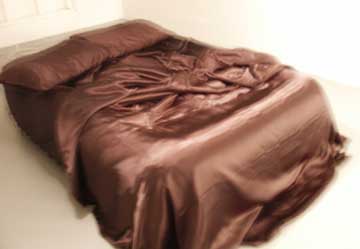
|
||
|
Portland art blog + news + exhibition reviews + galleries + contemporary northwest art
|
||
Johann Neumeister at Rock's Box  L to R Unica Zurn, Virginia Woolf and Valarie Solanas Portland is currently teeming with more interesting alternative spaces than ever before but Rock's Box has earned some distinction in less than a year with the only thing that really matters; four consistently intelligent, daring and engaging shows. Admittedly, these weren't all necessarily masterpieces but they were challenging and consistently professionally executed (note: proprietor Patrick Rock is himself one hell of an artist [with an MFA from SFAI] and a rare native Portlander).  The latest show, "Johann Neumeister - is - Dr. Herbert Dreadful Introducing: Psychopsychoanalysis" is easily the tightest and most impressive show at Rock's Box to date. Upon entering the first of three rooms one encounters three strange uterine sculptures and a series of paintings of historically complicated women including Valarie Solanas (she shot Andy Warhol), Virginia Woolf and artist Unica Zurn (Hans Bellmer's girlfriend). All of the paintings are resting neatly on the floor while leaning against the wall. Across the room the anatomically inaccurate sculptures seem to display models of monstrous or at least highly unusual uteruses. There are also a series of open ended questions designed to set up expectations on the poster for the show like; "How do I determine if I need a Psychopsychoanalysis treatment?" "Is the Psychopsychoanalysis crazy?" "Do I lie on a couch?" …etc. The mood is an unsettlingly misogynistic barrage, provoking the impression of a waiting room as a form of institutional critique (both the gallery system and the often very sexist nature of old style Freudian analysis). One should note space (in both galleries and offices) is often a projection of power and the patients/paintings here seem to have very little, while the monstrous genitals take on a kind of trophy status. Thus, Neumeister's Dr. is playing the misogynist and it brings back everything I read by Elaine Showalter and the movie Dead Ringers. Neumeister being an Austrian would be well acquainted with his countryman Freud's history. For example, Freud and his compatriot Josef Breuer gained great reknown through the case of Anna O which can be generally characterized as a kind of psychosexual tug of war between the paternalistic psychoanalyst and the "hysterical" patient. It isn't the way modern psychology is practiced anymore and one senses that Neumeister's Psychopsychoanalysis is just another purposefully irrationally arty take on psychoanalysis. It is however interesting as art turning the viewer into a hack psychologist or beleaguered patient, but weve seen this many a times. In the movies it was done best in Mel Brooks' High Anxiety. 
Video with some pretty peculiar vacuuming What an art exhibition does better than any movie though is allow one to explore and experience things actively and this show is very well laid out. The next room definitely starts to fracture Dr. Deadful's psychological practice with a video and three white chair frames. On the video screen we see the character of a cleaning lady vacuuming the top of a shiny metal table next to an aluminum Eamco chair. For the armchair psychologist it prompts the diagnosis of obsessive compulsive behavior since the shiny surface reveals that it is already clean. As behavior this definitely isn't a productive pastime but as art is it really something that needs to be cured? It is also a funny indictment on the yuppie fetish of brushed metal surfaces and new fangled vacuuming.  How professional is the Dr? Last but not least is Dr. Herbert Dreadful's office, consisting of a bed with black satin sheets, a huge ashtray stuffed with cigarettes, a fan and a classic artists joke on the wall about a collector where the doctor's certification should normally be. When Portland artist Jesse Hayward was being analyzed we heard some primal screams during the session (that is gonna happen when you speak to Jesse eventually). Clearly, the show is about being an artist always being, scrutinized, sorted and labeled as well as the way artists always defy the expectations placed upon them. Overall, this is a fine show for the art crowd that doesn't try to hard to be feminist or arty while discussing the artistic need to avoid conformity. Unlike real psychology, the results here don't really matter as much as the opportunity to put oneself into the gallery/skinnerbox and explore how clinical experiences are a lot like the way spaces and our expectations institutionalize art. Open Sat & Sun 12-6 Runs through March 2nd 2008 Posted by Jeff Jahn on February 14, 2008 at 13:49 | Comments (0) Comments Post a comment Thanks for signing in, . Now you can comment. (sign out)
(If you haven't left a comment here before, you may need to be approved by
the site owner before your comment will appear. Until then, it won't appear
on the entry. Thanks for waiting.)
|
| s p o n s o r s |
 |
 |
 |
 |
 |
 |
 |
 |
 |
 |
 |
 |
 |
 |
 |
 |

|
Site Design: Jennifer Armbrust | • | Site Development: Philippe Blanc & Katherine Bovee | |

